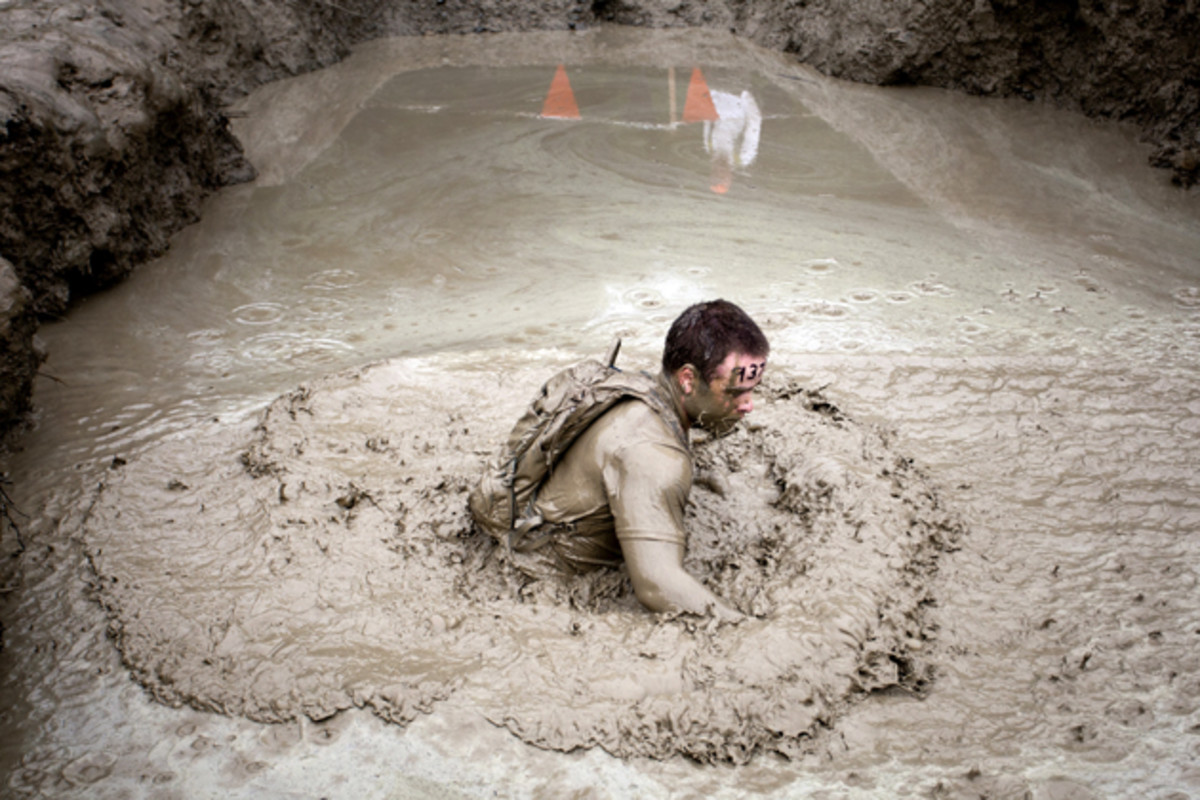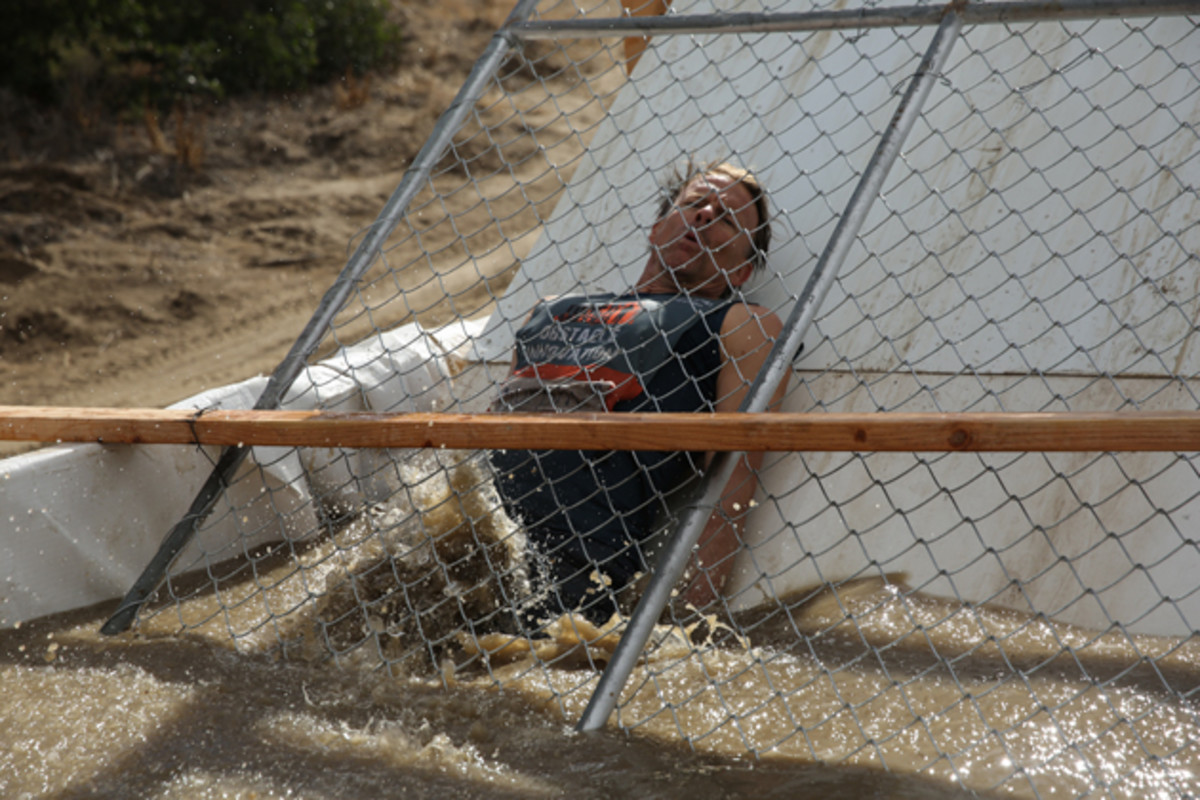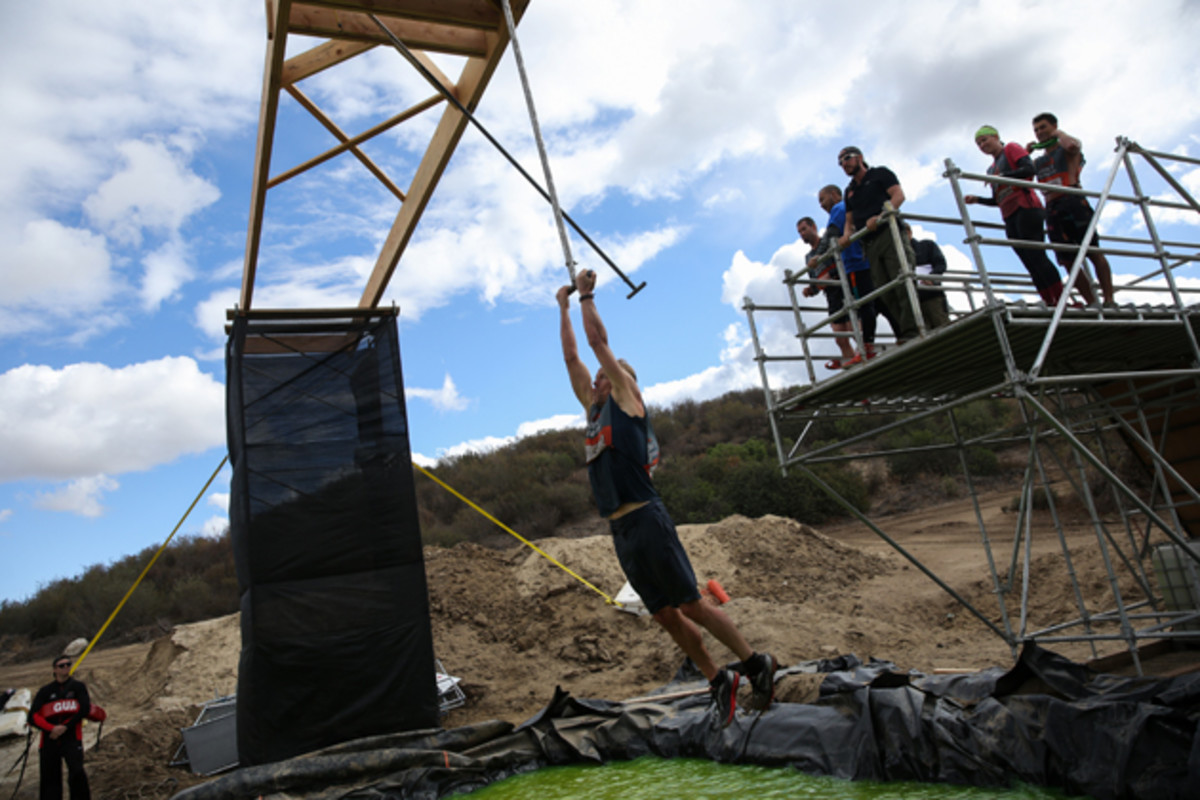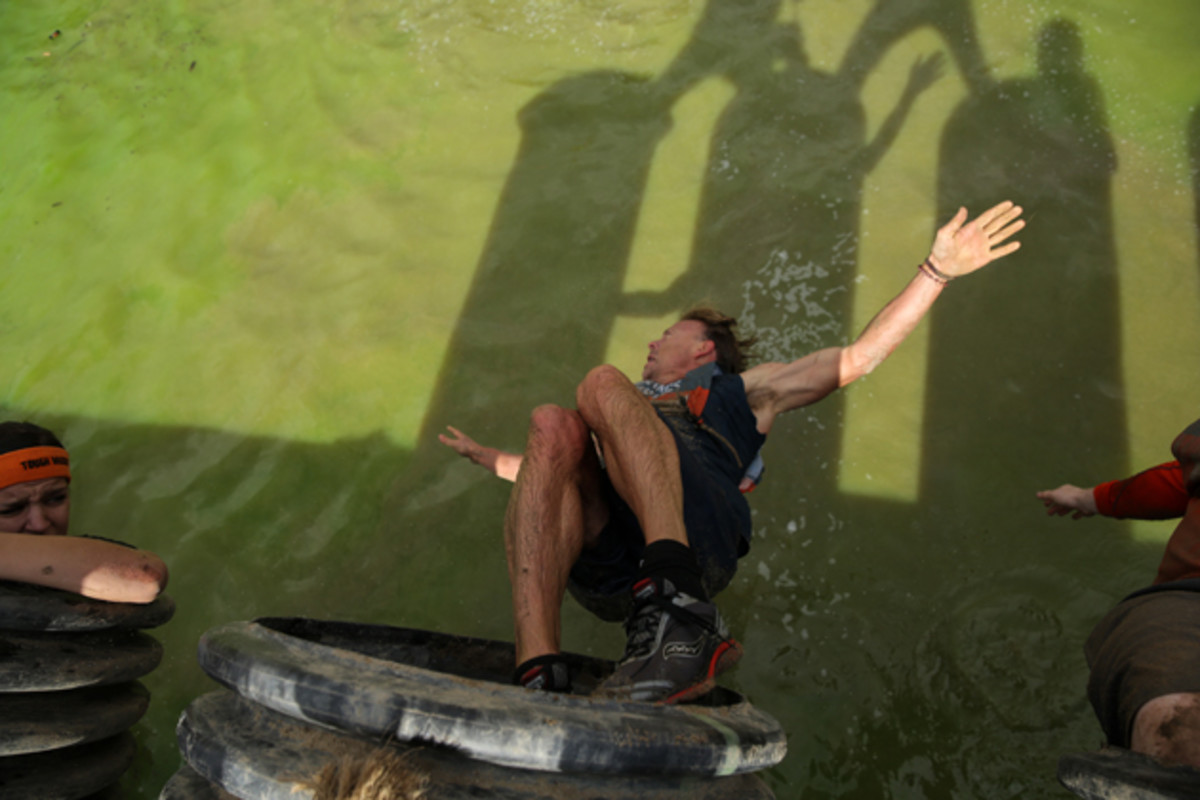Mud, sweat and tears: My day as a Tough Mudder crash-test dummy

When I shared with friends that I was looking forward to getting a taste of Tough Mudder, I didn’t mean that I wanted to eat part of an obstacle, although that, regrettably, is what happened as I navigated an ordeal called the Meat Slab, in which Mudders hop across a near-vertical 50-foot-long wall, or “slab,” by swinging from one rope to the next, as Tarzan might traverse a cliff. Attempting to sail gracefully off the apparatus I miscalculated, careening chin-first into the “slab,” ingesting minute particles of it and partially dislocating my jaw. “Hey,” noted my partner, Gina, when I got home, “your face is different!”
I didn’t see stars upon impact. I did see a shaft of white light, then the silhouettes of teammates asking, “Are you okay?” Other than the jaw issue—for a few weeks, the teeth on the left side of my face failed to “line up” properly—and a mild concussion, I was splendid … if one was also willing to overlook the pulled hamstring, torn shoulder muscle and bloodied knees I’d incurred earlier on the course, and the hypothermia still to come.
But really, that’s what we’re paying for, right? It’s why we sign on for these adventures: to gather scrapes and stories—evidence that we’ve escaped, however briefly, our bourgeois existences; left our comfort zones, like Thoreau on Walden Pond, to “suck out all the marrow of life.”

Or, in my case, to suck, period, when it came the Meat Slab and Cover Your Stump—another obstacle I made a hash of. And that’s okay. Struggling to get over (and under) these impediments didn’t make me a bad person. It made me a defensive, insecure person, concocting such excuses as: You’re a mud virgin, while almost everyone else here has done multiple Tough Mudders.
In fact, we were all newbies on this day. This was Tough Mudder’s Beta Test Event, held last month on the shores of Vail Lake, nestled among coastal mountains 100 miles southeast of Los Angeles. Signs identified the site as an “Obstacle Innovation Lab.” On this day, we would serve as guinea pigs on newfangled torments.
The first Tough Mudder was held in 2010, in Pennsylvania. Co-founder Will Dean, an ex-pat Brit and freshly minted MBA from the Harvard Business School, had entered his brainchild in the school’s Business Plan Contest. It was a semi-finalist. Dean had hoped to get 500 people to sign up for the first event; his professors found that overly optimistic.
Some 4,500 people registered for that maiden Mudder. In 2015, the number of people to have completed a Tough Mudder will surpass 2 million. Its courses generally feature 20 to 25 obstacles over a 12-mile course. Next year, the company will put on 60 events in seven countries. Customers pay between $99 and $150 to “play.” To keep it fresh for repeaters, or “multi-Mudders,” also known in TM circles as Legionnaires, the company cycles in new and different obstacles each year—but only after they’ve undergone the Beta testing my fellow human guinea pigs and I would provide. As clipboard-wielding employees gleaned feedback from shivering, bloodied—yet overwhelmingly happy, even euphoric—participants, I was reminded of Count Rugen’s debriefing of Wesley in The Princess Bride, after sucking away a year of his life with “The Machine”:
“What did this do to you? And remember, this is for posterity, so be honest.”
Grueling yet addictive, cyclocross pushes boundaries of physical limits
To be completely honest, Tough Mudders annoyed me. I resented them, and their cult-like smugness, right up until the day I met them, and laughed and worked and suffered and bled with them.
It is the alpha event of a very alpha category. MOB (Mud, Obstacles, Beer) runs such as Tough Mudder, the Warrior Dash and Spartan Race, represent the fastest-growing segment of the action/endurance market. Yet, I’d resisted signing up for one. The way Tough Mudder presented itself struck me as a bit too testosterone-drenched, aimed, for instance, at the hammerhead who takes pleasure in buzzing me in his pickup truck when I’m out on my road bike; the sort of yahoo who was disappointed when Monday Night Football finally got rid of Hank Williams Jr.
The company’s website copy rubbed me the wrong way, implicitly diminishing events I’d completed—triathlons, gran fondos, adventure races—seeming to suggest that I hadn’t really challenged myself until I’d graduated to a Tough Mudder. It made me want to finish one of these mudfests just to rub it in their faces; to be able to say, upon completion, “I’ve done worse.”

That, of course, is precisely the response Dean, et al., hope to provoke. And after coming off the Beta Test course, it held true: I had suffered more—in a quantitative sense—in other events, such as the three-and-a-half-day Appalachian Extreme adventure race in 2003. I will hand it to Tough Mudder, however: no event I’ve ever done succeeds quite so well at distilling pain. A Mudder’s moments of misery—immersion in ice water; exposure to electric shocks and, in a special torment unveiled for us at Vail Lake, tear gas—are intense, but brief. Of course, the knowledge that they’re out there on the course, lying in wait, tends to prey on one’s mind.
Those fleeting tortures are interspersed with, and offset by, moments of gut-busting fun. Our first obstacle out of the gate was Greased Lightning, a downhill, 100-yard slip-and-slide, at the bottom of which waited a pond of brown water. I was laughing so hard when I hit the pond I ended up drinking a gallon or so of it.
These were fast-food obstacles, a total hoot, but over quickly. The experiences that stayed with me, that lingered, and nourished the spirit, were the ones calling for team building and selflessness.
“We live in this world where we’re all increasingly connected,” Will Dean was telling me, 90 minutes before we, his human crash dummies, were released on the course. “But we’re not truly connected. I think 20 years ago more people did things like play in softball leagues.” In a world of vanishing community, he believes, Tough Mudder offers shared experience, membership in a tribe.
“Some people think we’re against marathons or triathlons,” Dean continued. (To be sure, his company failed to endear itself to the running community with this nugget from its website: “Fact #2—Marathon running is boring. Running in a straight line for hours on end may give you a healthy set of lungs, but your arms will still look like Keira Knightly’s.”)
“It’s not that. Those [events] serve a certain type of need. Here, the group dynamic’s really important, the sense that you’re helping people through things.”
[pagebreak]

I was sitting in my car in a near-empty parking lot at Vail Lake, blasting the heater, when he pulled up next to me. Twenty-something, wavy hair, dashing. It was 54 degrees, and this guy gets out of his car wearing board shorts and a tank top. He was ripped, and was going to make sure everyone knew it. Already I didn’t like him.
Fast-forward two hours. My fellow Betas and I have been divided into teams of a dozen. I’m in Group D. After whooping down Greased Lightning, then pulling a hammy sprinting through “Insane Bolt,” then post-holing through the Mud Mile—our squad was slowed by two teammates who lost shoes in the muck—we arrived, eventually, at Everest.
Everest is Tough Mudder’s most iconic obstacle, not just because of its formidable appearance: a quarter pipe fifteen feet high. It forces the lone wolves, the strong, silent types, to work with others, to accept help from strangers.
While an elite few athletes are able to generate sufficient speed and traction to latch onto the railing atop the obstacle, then pull themselves up, most of us needed help. Hamstrung and hobbling, I came up well short of the railing, but latched onto an outstretched arm and held on, while swinging my left leg vainly upward. No takers. As my leg slid down, the guy clutching my right hand grunted with supreme exertion. He was now holding on to all 178 pounds of me. He could’ve let me fall; I wouldn’t have blamed him. Bracing himself, he held on. I swung the leg up again; someone grabbed it, and pulled me over. The guy who refused to drop me? Board Shorts, of course.
By then, we were buddies and teammates. Dude, you’re gonna freeze, I told him, when he took the start shirtless, covered only by the Tough Mudder pinney. He came right back at me. “My experience has been that, once you get wet, your clothes stay wet, whereas your skin at least has a chance to dry off. So you’ll probably end up colder than I am.
He got that right.
I Will Survive: Going Wild at the Bear Grylls Survival Academy
As good as it felt to summit Everest, it felt better to take my turn at the top, pulling perfect strangers over the threshold, paying it forward. Yes, it’s a gantlet of torments. But Tough Mudder is also, as head course designer Nolan Kombol sees it, “a huge social experience. You’ll see people who’ll stay on top of Everest and help 15 or 20 people over.”
Where physical contact with a stranger on the subway, for instance, is often unwanted, Kombol notes, “here you actually get to extend a hand to a stranger, make eye contact, have an experience that says, ‘I don’t know who you are, you don’t know who I am, but we’ve made a connection. We’re in this together, we’re getting through this together.’”
Dirty D, as we called our team, was bonding nicely. Earlier, we’d Army-crawled under plastic sheets holding hundreds of gallons of water. This uniquely aquatic, claustrophobic sensation, sort of like being trapped under a waterbed, is called the Birth Canal. It looks innocuous, until you get stuck halfway through, as happened to a woman to my left, who came close to panicking, but was talked down by her boyfriend. Upon emerging from the canal, some of us then pulled our teammates the last few feet, midwifing them, as it were. In keeping with the childbirth theme, we bawled like newborns. Later, I would find myself wanting to cry for real.
If I’d been looking forward to one obstacle, it was Cover Your Stump, a knock-off of “Ring Toss” on American Ninja Warrior. Holding a ring in each hand, contestants advance up, and then down, a series of pegs. On a recent flight from some NFL city, I’d watched Kacy Catanzaro crush the Ring Toss (fast forward to 1:40) and thought, “I’d probably be pretty good at that.”
It was my second-sorriest showing of the day, after the Meat Slab debacle. On two attempts, I barely got past the halfway point. Rather than sulk, I vowed to make pull-ups a more regular part of my workouts. And I drew genuine inspiration from the three women on Team D who, channeling Kacy, finished the obstacle. Tricia, Phoebe, Phoebe’s friend with the pink neon shades: you’re my heroes.

While Stump humbled me, it took Electroshock Therapy to bring me to my knees. Literally. Before venturing into this welter of dangling wires, some of them with 10,000 volts running through them, I’d drawn out some of my teammates on how much it hurt.
Is it like pressing your tongue against both terminals of a nine-volt battery—is it uncomfortable like that?
Rene, a compactly build Legionnaire from LA, laughed. “I was an electrician’s assistant, and got shocked all the time with 110 volts. This is way worse, man.”
It’s not the voltage that kills you, someone explained. It’s the amperes. By dialing down the amps, Tough Mudder … spares our lives.
But not my knees. This updated version of Electroshock, a Mudder perennial, featured those charged wires dangling over an obstacle course of hay bales and mud moguls. I got zapped three times. Each jolt hurt a little more, the third one rocking my world, robbing me of motor control. I collapsed, landing hard on my knees, shredding the skin on both. Those scabs disappeared right around the time my jaw started feeling normal.
***
Kombol, the mad scientist behind these obstacles, is a handsome, ginger-haired outdoorsman and elite mountain climber. Upon meeting him that morning, I’d referred to him, in jest, as the company’s “resident sadist.”
“It’s a good joke,” he replied, smiling politely, “and I get that all the time.” Just in case you thought your little quip was remotely original. “But really, when I approach this, it’s not about creating stuff that’s going to punish or torture people. It’s about creating a unique and novel experience.” At its essence, he believes, Tough Mudder is “an outlet for people to do things they really wouldn’t do anywhere else”—which explains one of its unofficial slogans: Ironman meets Burning Man. “Something unconventional, something that none of their friends or colleagues have done. So when they come back they have a story to tell.”
While the 10,000 volts were short-circuiting my central nervous system, I needed to remember that Electroshock Therapy was coming from a place of novelty, not cruelty. “When we first came up with Electroshock, we weren’t asking ourselves, ‘How can we shock people?’” says Kombol. “It was more of, ‘What’s something mentally challenging that people are afraid of?’ We wanted to create a fear-based obstacle.’”
Falcons GM Thomas Dimitroff: What drives the NFL's fittest exec?
The shocking and collapsing, those were incidental to the experience; just as uncontrollable shivering was a byproduct of full immersion in the Arctic Enema, a tank filled with 34-degree water; just the burning sensation in our eyes, and the feeling of having Sriracha poured into every one of our tiny cuts and abrasions, was a result of crawling through Cry Baby, a tent filled with what the organizers referred to as "tear gas." (Full disclosure: While it certainly stings, the active ingredient in this concoction is more benign than the one in real tear gas.)
We reserve the right to bitch about pain. But—and herein lies part of the genius of Tough Mudder—we wouldn’t miss it for the world. It’s part of what we’re paying for. (I’m speaking figuratively: the Beta test event was free to all invitees). As Dean notes, there’s a perverse dynamic in play. “Whenever you hear about someone being tased, you think, Well, that sounds like it would suck. But there’s a little part of you that wants to know what it’s like.”
Before he went to the Harvard Business School, Dean was a counterterrorism officer, working closely with British Special Forces. The Tough Mudder course is designed to have a Special Forces “feel,” emphasizing the importance unit cohesion, of working as a team. But where’s the teamwork in getting shocked to the point of voiding one’s bladder?
I was missing the point, posing such questions. Also central to the Special Forces “ethos,” Dean explained to me, is the idea “that it’s mental as much as it is physical.”
'Boundless' Stars Paul Trebilcock & Simon Donato on Endurance Races
Okay, I get it. We needed to be mentally tough, needed to conquer our fears. But how many times? After enduring Electroshock Therapy in the morning, we were asked to subject ourselves to its cousin, The Electric Slide—a sliding board through still more 10,000-volt tentacles—in the afternoon. I took a pass, recalling Falstaff, who feigns death on the battlefield to save his life, later arguing, “The better part of valor is discretion.”
The afternoon provided minor triumphs. I got up and over the Berlin Wall, unassisted. On my second attempt—after yet another slapstick plunge into a muddy pool dyed nuclear green—I made it across the latest version of Funky Monkey, a glorified, elevated, inclined set of monkey bars. Working smoothly together, our unit of four guys maneuvered a 250-pound log through an obstacle course called Hold Your Wood. (To peruse Tough Mudder’s vaguely adult-themed and self-consciously scatological obstacle titles is to surmise that Beavis and Butthead are on the payroll.)
If the morning’s highlight was Everest, my favorite obstacle of the afternoon was a slick, tall, inclined wall called Pyramid Scheme. Instead of trying to scrabble up the slope individually, we formed a human pyramid. After stepping on the shoulders of our new friends to reach the top, we reached down to pull our fellows up. It wasn’t always smooth. You heard such objections as “Watch my head!” and “Ow, OW—you’re stepping on my neck!” But in a remarkably short time, we all stood atop the obstacle, high-fiving. Phoebe shouted to mountaintops, “DIRTY D!” which served as our rallying cry for the rest of the day.
When we were done, but not before we’d stopped shivering, I hugged and shook hands with my teammates, telling them I’d see them down the road. I meant it. I was wrong to pre-judge Mudders, who in the main were great, strong, selfless people; and who have no interest in buzzing me in their pickups, if they even drive pickups. I’ve already vowed to do one more of these, and to bring Gina with me. I look forward to redeeming myself on the Ring Toss, to finishing the Meat Slab, minus the face plant. Come what may, it will be fun to have more stories to tell.
